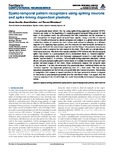Spatio-temporal pattern recognizers using spiking neurons and spike-timing-dependent plasticity.
| dc.contributor.author | Humble, J | |
| dc.contributor.author | denham, susan | |
| dc.contributor.author | Wennekers, Thomas | |
| dc.date.accessioned | 2016-07-28T19:34:43Z | |
| dc.date.available | 2016-07-28T19:34:43Z | |
| dc.date.issued | 2012-10-10 | |
| dc.identifier.issn | 1662-5188 | |
| dc.identifier.issn | 1662-5188 | |
| dc.identifier.other | ARTN 84 | |
| dc.identifier.uri | http://hdl.handle.net/10026.1/5137 | |
| dc.description.abstract |
It has previously been shown that by using spike-timing-dependent plasticity (STDP), neurons can adapt to the beginning of a repeating spatio-temporal firing pattern in their input. In the present work, we demonstrate that this mechanism can be extended to train recognizers for longer spatio-temporal input signals. Using a number of neurons that are mutually connected by plastic synapses and subject to a global winner-takes-all mechanism, chains of neurons can form where each neuron is selective to a different segment of a repeating input pattern, and the neurons are feed-forwardly connected in such a way that both the correct input segment and the firing of the previous neurons are required in order to activate the next neuron in the chain. This is akin to a simple class of finite state automata. We show that nearest-neighbor STDP (where only the pre-synaptic spike most recent to a post-synaptic one is considered) leads to "nearest-neighbor" chains where connections only form between subsequent states in a chain (similar to classic "synfire chains"). In contrast, "all-to-all spike-timing-dependent plasticity" (where all pre- and post-synaptic spike pairs matter) leads to multiple connections that can span several temporal stages in the chain; these connections respect the temporal order of the neurons. It is also demonstrated that previously learnt individual chains can be "stitched together" by repeatedly presenting them in a fixed order. This way longer sequence recognizers can be formed, and potentially also nested structures. Robustness of recognition with respect to speed variations in the input patterns is shown to depend on rise-times of post-synaptic potentials and the membrane noise. It is argued that the memory capacity of the model is high, but could theoretically be increased using sparse codes. | |
| dc.format.extent | 84- | |
| dc.format.medium | Electronic-eCollection | |
| dc.language | eng | |
| dc.language.iso | eng | |
| dc.publisher | Frontiers Media SA | |
| dc.subject | neural automata | |
| dc.subject | sequence learning | |
| dc.subject | spike-timing-dependent plasticity | |
| dc.subject | spiking neurons | |
| dc.subject | synfire chains | |
| dc.title | Spatio-temporal pattern recognizers using spiking neurons and spike-timing-dependent plasticity. | |
| dc.type | journal-article | |
| dc.type | Article | |
| plymouth.author-url | http://www.ncbi.nlm.nih.gov/pubmed/23087641 | |
| plymouth.issue | SEPTEMBER | |
| plymouth.volume | 6 | |
| plymouth.publication-status | Published online | |
| plymouth.journal | Front Comput Neurosci | |
| dc.identifier.doi | 10.3389/fncom.2012.00084 | |
| plymouth.organisational-group | /Plymouth | |
| plymouth.organisational-group | /Plymouth/Admin Group - REF | |
| plymouth.organisational-group | /Plymouth/Admin Group - REF/REF Admin Group - FoSE | |
| plymouth.organisational-group | /Plymouth/Faculty of Science and Engineering | |
| plymouth.organisational-group | /Plymouth/Faculty of Science and Engineering/School of Engineering, Computing and Mathematics | |
| plymouth.organisational-group | /Plymouth/REF 2021 Researchers by UoA | |
| plymouth.organisational-group | /Plymouth/REF 2021 Researchers by UoA/UoA04 Psychology, Psychiatry and Neuroscience | |
| plymouth.organisational-group | /Plymouth/REF 2021 Researchers by UoA/UoA11 Computer Science and Informatics | |
| plymouth.organisational-group | /Plymouth/Research Groups | |
| plymouth.organisational-group | /Plymouth/Research Groups/Centre for Brain, Cognition and Behaviour (CBCB) | |
| plymouth.organisational-group | /Plymouth/Research Groups/Centre for Brain, Cognition and Behaviour (CBCB)/Brain | |
| plymouth.organisational-group | /Plymouth/Users by role | |
| plymouth.organisational-group | /Plymouth/Users by role/Academics | |
| dc.publisher.place | Switzerland | |
| dcterms.dateAccepted | 2012-09-24 | |
| dc.identifier.eissn | 1662-5188 | |
| dc.rights.embargoperiod | No embargo | |
| rioxxterms.versionofrecord | 10.3389/fncom.2012.00084 | |
| rioxxterms.licenseref.uri | http://www.rioxx.net/licenses/all-rights-reserved | |
| rioxxterms.type | Journal Article/Review |


